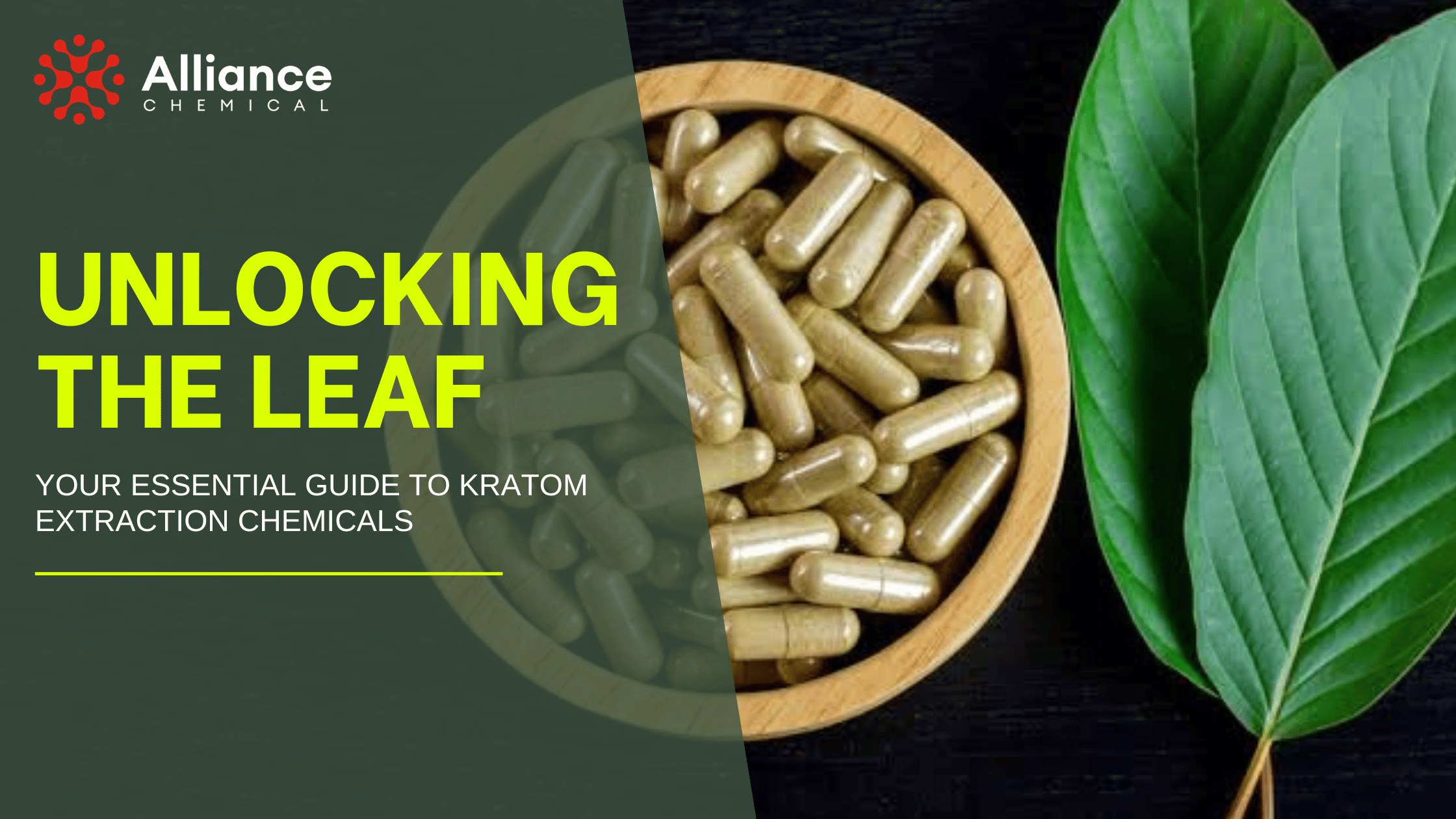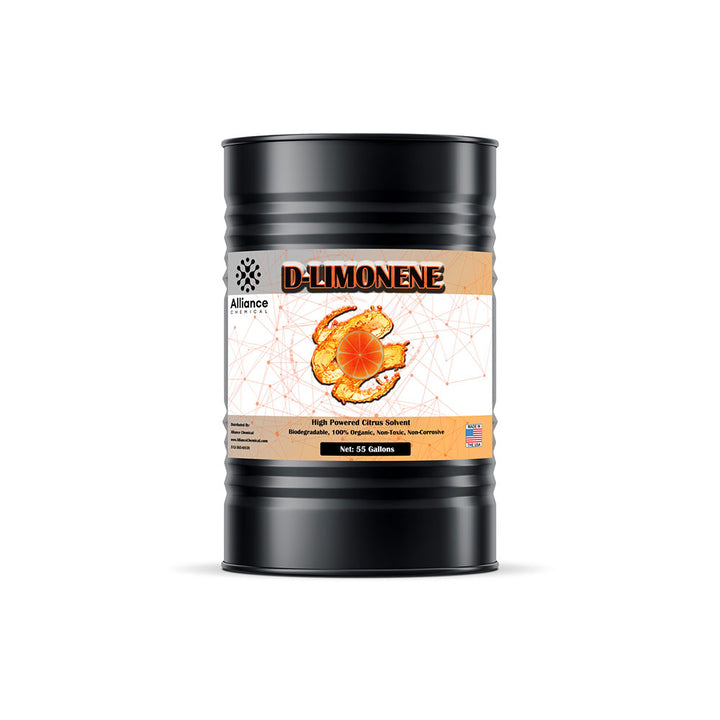
Unlocking the Leaf: Your Essential Guide to Kratom Extraction Chemicals
Table of Contents
What you will learn
📋 What You'll Learn
This guide walks you through unlocking the leaf: your essential guide to kratom extraction chemicals with detailed instructions.
The Kratom industry is experiencing explosive growth, shifting focus from simple leaf powder to sophisticated extracts. For producers in this dynamic space, mastering the extraction process is key. This means understanding not just the what – the essential chemicals – but also the how – the methods used to isolate Kratom's valuable alkaloids like Mitragynine and 7-hydroxymitragynine.
This guide dives deep into both. We'll explore common Kratom extraction workflows and pinpoint where critical chemicals like D-Limonene and Acetic Acid come into play. Whether you're refining your methods in a botanical lab or scaling up production, using the right high-purity chemicals is non-negotiable for achieving potent, clean extracts.
At Alliance Chemical, we're more than just suppliers; we're your partners in the extraction industry. We provide the reliable, high-quality, often American-produced chemicals you need, cutting through the noise of inconsistent imports. Let's equip you with the knowledge and the materials for success.
Table of Contents:
- Why Kratom Extracts? Understanding the Driving Force
- The Source Material: Kratom
- The Chemistry of Kratom Extraction: Unlocking Alkaloids
- Understanding the Kratom Extraction Process: Common Methods
- Essential Chemicals for Kratom Extraction: The Core Toolkit
- Quality Matters: Grade, Source, and the Alliance Chemical Advantage
- Safety First: Responsible Chemical Handling in Extraction
- Your Trusted Source for Kratom Extraction Chemicals
Why Kratom Extracts? Understanding the Driving Force
The move towards extracts is fueled by tangible benefits:
- Potency & Consistency: Concentrated alkaloids offer predictable effects compared to variable raw leaf.
- Versatility: Enables diverse product formats beyond traditional consumption methods.
- Targeted Research: Allows R&D focus on specific alkaloids and their properties.
- Consumer Demand: Meets the market's desire for potent, convenient botanical products.
Achieving these benefits efficiently relies on well-executed extraction protocols using quality chemicals.
The Source Material: Kratom
Everything starts with the leaves of the Mitragyna speciosa tree, native to Southeast Asia. These leaves contain the target alkaloids that extraction processes aim to concentrate.

The Chemistry of Kratom Extraction: Unlocking Alkaloids
At its core, extraction uses chemical principles to separate desired compounds (alkaloids) from the plant material. Solvents dissolve the alkaloids, while acids (and sometimes bases) manipulate their chemical form (freebase vs. salt) to control their solubility in different liquids. This allows for selective separation and purification.
Understanding the Kratom Extraction Process: Common Methods
While proprietary methods exist, many Kratom extractions utilize variations of established botanical techniques. It's crucial to understand that these are simplified overviews; actual processes require careful optimization and safety protocols. This is not a DIY guide.
Acid/Base Extraction Principles
This common technique leverages the fact that alkaloids are bases. By changing the pH, you can drastically alter their solubility:
- Acidification: Ground Kratom leaf is mixed with an acidic solution (e.g., water mixed with Acetic Acid or Citric Acid). The acid converts the alkaloids into their salt forms (e.g., mitragynine acetate). These salts are typically soluble in polar solvents like water or ethanol.
- Extraction: The acidified mixture is often steeped or washed with a polar solvent (like water or slightly acidic Ethanol) to dissolve the alkaloid salts, pulling them out of the plant material. The solid plant matter is filtered out.
- Basification (Optional Purification Step): A base (like a dilute solution of Sodium Hydroxide or Ammonium Hydroxide) is carefully added to the liquid extract. This raises the pH, converting the alkaloid salts back into their freebase form.
- Separation (Optional Purification Step): The alkaloid freebases are often much less soluble in water but more soluble in a non-polar solvent (like D-Limonene, Hexane, or Heptane). Adding such a solvent at this stage allows the freebase alkaloids to move into the non-polar layer, leaving water-soluble impurities behind. The layers are then separated.
- Evaporation: The solvent containing the alkaloids (either the initial polar solvent or the later non-polar solvent) is carefully evaporated (often using rotary evaporators or vacuum ovens) to leave behind the concentrated Kratom extract.
This process allows for significant purification by selectively moving alkaloids between different liquid phases based on pH.
Solvent Extraction (Maceration/Percolation)
This method focuses primarily on the dissolving power of solvents, sometimes with acid pre-treatment:
- Preparation: Dried, ground Kratom leaf is prepared. Sometimes it's pre-treated with a mild acid solution (using Acetic Acid or Citric Acid) to aid alkaloid solubility, but not always.
-
Extraction (Maceration or Percolation):
- Maceration: The Kratom powder is soaked (macerated) in a chosen solvent (e.g., Ethanol, Isopropyl Alcohol, potentially D-Limonene, or even food-grade options depending on the goal) for a set period, often with agitation, allowing the alkaloids to dissolve.
- Percolation: The solvent is slowly passed through a column packed with the Kratom powder, continuously dissolving alkaloids as it flows.
- Filtration: The liquid extract (miscella) is carefully separated from the solid plant material via filtration.
- Evaporation: The solvent is removed from the miscella, typically through evaporation under controlled temperature and vacuum, leaving the crude Kratom extract. Further purification steps might follow if needed.
The choice of solvent here is critical, balancing extraction efficiency with safety and ease of removal. Alcohols like Ethanol and IPA are very common.
Essential Chemicals for Kratom Extraction: The Core Toolkit
Based on these processes, let's revisit the key chemical players:
1. Solvents: The Primary Extractors
They dissolve the alkaloids. Your choice impacts yield, purity, and safety.

Spotlight On: D-Limonene – The Natural Powerhouse
D-Limonene is valued for:
- Effectiveness: A potent non-polar solvent, useful in specific purification steps (like separating freebase alkaloids) or potentially as a primary solvent in some protocols.
- Natural Origin & Aroma: Derived from citrus, offering a "greener" profile than some synthetic solvents.
- Grade Options: Find Technical Grade and high-purity USP Grade for demanding applications.
Supply Stability: Facing market volatility? Alliance Chemical prioritizes reliable sourcing, often featuring American-produced D-Limonene, providing a more stable supply chain than relying solely on fluctuating imports. We strive to "have IT ALLWAYS" for our customers.
Other Key Solvents:
- Ethanol: The workhorse polar solvent. Highly effective, relatively safe, widely used. Available in various proofs and denaturations like Denatured Alcohol 200 Proof SDA 3A.
- Isopropyl Alcohol (IPA): Another effective, common alcohol solvent. Available up to high purity ACS Reagent Grade (99.9%). (See IPA concentration guide).
- Acetone: Strong polar solvent, extracts quickly but needs careful handling for selectivity. Offered in Technical and ACS Grades.
- Non-Polar Hydrocarbons: Hexane / Heptane are mainly used in multi-step purifications (defatting, liquid-liquid extraction). Require stringent safety measures. ACS Grade available.
Find the right solvent in our Solvents collection.
2. Acids: Enhancing Solubility and Control
Used to convert basic alkaloids into more soluble salts and control pH.

Spotlight On: Acetic Acid – The Versatile pH Adjuster
Acetic Acid is essential for:
- Salt Formation: Efficiently creates alkaloid acetate salts for better extraction into polar solvents.
- pH Control: Allows gentle and precise acidification.
- Grade Variety: Choose from Technical, high-purity ACS Grade, or Food Grade Glacial Acetic Acid based on your needs.
Other Key Acids:
- Citric Acid: A mild, food-grade friendly option for acidification and forming citrate salts. Available as solid (USP/Food Grade) or 50% Solution.
Browse our full range of Acids.
3. Bases: Facilitating Purification
Used selectively in Acid/Base methods to convert alkaloid salts back to freebase form for separation.
- Sodium Hydroxide (NaOH) / Potassium Hydroxide (KOH): Strong bases for significant pH increase. Available in ACS Grade flakes and solutions. Handle with extreme care.
- Ammonium Hydroxide: Milder base for more controlled adjustments. ACS Grade available.
See our Bases and Caustics selection.
4. Essential Support Chemicals & Supplies
Don't forget the necessities for smooth operation and quality control:
- Buffers: For precise pH stability.
- Drying Agents: Like Silica Gel to remove residual moisture.
- Cleaning Solutions: Essential for equipment hygiene (e.g., 70% IPA).
- Appropriate Containers: For safe storage and handling (from jugs to drums).
Quality Matters: Grade, Source, and the Alliance Chemical Advantage
In extraction, chemical quality is paramount. Using low-grade or contaminated chemicals is a recipe for low yields, impure products, and safety hazards. Always verify the Chemical Grade (Technical, USP, ACS, Food Grade) matches your process requirements.
Alliance Chemical prioritizes quality and reliability. We focus on high-purity chemicals, often from traceable American producers, minimizing the risks associated with inconsistent "imported trash." Trust us for the quality your process demands.
Dependable Quality for Demanding Processes: That's the Alliance Chemical commitment.
Safety First: Responsible Chemical Handling in Extraction
This cannot be stressed enough: Working with extraction chemicals requires strict adherence to safety protocols. This guide is informational, not instructional for hands-on work.
- SDS is Mandatory Reading: Understand hazards, handling, and emergency measures for EACH chemical.
- PPE is Non-Negotiable: Gloves, eye protection, lab coats are minimums. Respirators may be needed.
- Ventilation is Crucial: Use fume hoods or ensure exceptional airflow.
- Proper Storage Saves Lives: Follow SDS guidelines for segregation and conditions.
- Emergency Preparedness: Have spill kits, eyewash/shower stations ready and know procedures.
Prioritize safety above all else.
Your Trusted Source for Kratom Extraction Chemicals
Navigating the world of Kratom extraction requires expertise and reliable partners. Alliance Chemical offers:
- High-Purity Selection: The right grades (ACS, USP, Food Grade, Technical) for your specific needs.
- Targeted Inventory: Core solvents, acids, bases, and support chemicals crucial for Kratom work.
- Supply Chain Reliability: We work hard to keep essential chemicals like US-sourced D-Limonene in stock.
- Industry Insight: Expertise in the Extraction and Botanical sectors.
- Dedicated Support: Our team is ready to assist. Contact us!
Source the quality chemicals you need to produce exceptional Kratom extracts. Explore our essential collections:
Shop All Extraction Chemicals Browse Solvents Explore Acids
For bulk inquiries or specific chemical needs, get in touch with our specialists today!







